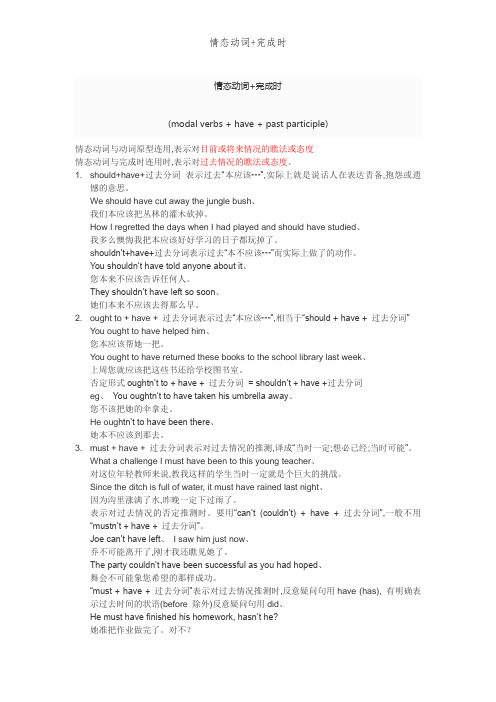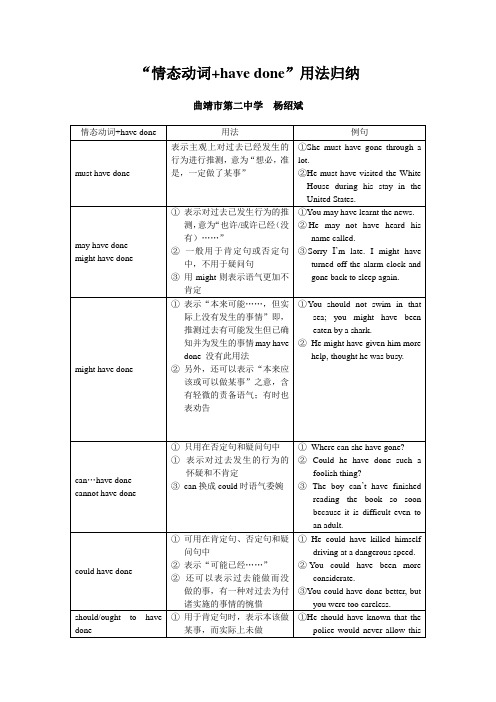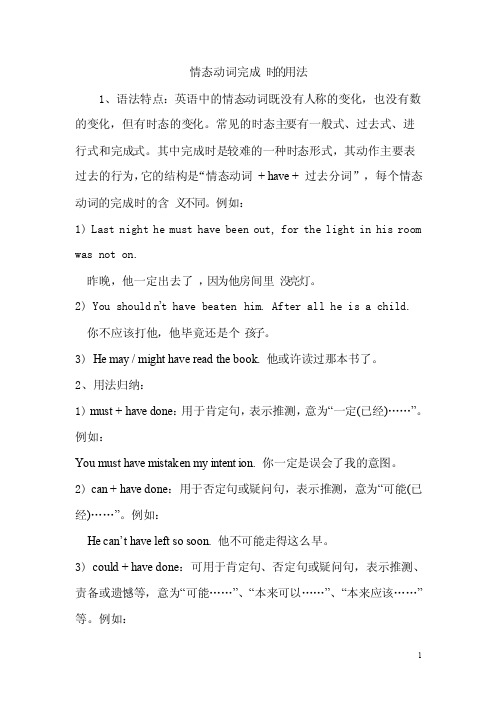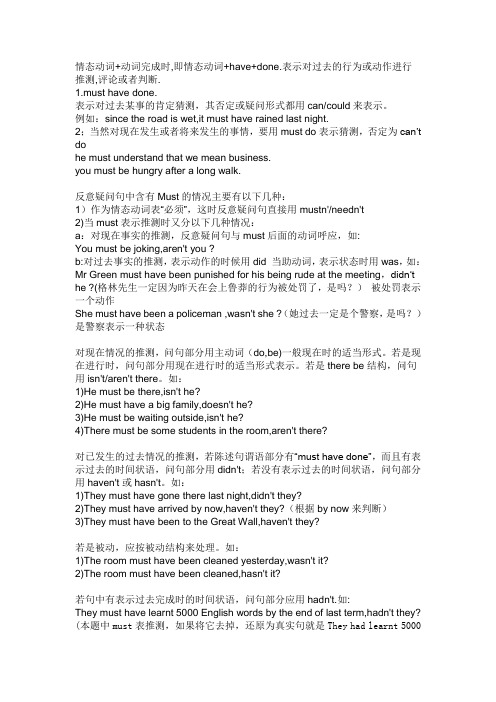情态动词后面接完成式
情态动词+完成时

情态动词+完成时(modal verbs + have + past participle)情态动词与动词原型连用,表示对目前或将来情况的瞧法或态度情态动词与完成时连用时,表示对过去情况的瞧法或态度。
1. should+have+过去分词表示过去“本应该┅”,实际上就是说话人在表达责备,抱怨或遗憾的意思。
We should have cut away the jungle bush、我们本应该把丛林的灌木砍掉。
How I regretted the days when I had played and should have studied、我多么懊悔我把本应该好好学习的日子都玩掉了。
s houldn’t+have+过去分词表示过去“本不应该┅”而实际上做了的动作。
You shouldn’t have told anyone about it、您本来不应该告诉任何人。
They shouldn’t have left so soon、她们本来不应该去得那么早。
2. ought to + have + 过去分词表示过去“本应该┅”,相当于“should + have + 过去分词”You ought to have helped him、您本应该帮她一把。
You ought to have returned these books to the school library last week、上周您就应该把这些书还给学校图书室。
否定形式oughtn’t to + have + 过去分词= shouldn’t + have +过去分词eg、You oughtn’t to have taken his umbrella away、您不该把她的伞拿走。
He oug htn’t to have been there、她本不应该到那去。
3. must + have + 过去分词表示对过去情况的推测,译成“当时一定;想必已经;当时可能”。
ought to, can, may, must, should, need情态动词+完成时态的用法

用情态动词表示现在对过去发生的事的看法应该用情态动词+完成不定式。
【错例】You ought to come yesterday,but you didn't.【改正】改come为have come。
【句意】你应该昨天来的,但是你没来。
【归纳】熟记下列情态动词+完成体动词所表示的含义及它们的用法:1) must+完成不定式表示对过去事情的推测,意思是“一定”,“必定”:You made a lot of mistakes yesterday. You must have been careless.你昨天错了不少,一定是粗心了。
2)■can(could)+完成不定式表示未来能做而未做,有时用来提出婉转的批评和表示懊悔。
意思是“本该”,“本来可以”:He came here on foot,but he could have come by bus.他步行来的,但他本来可以乘公共汽车来的。
You could have come five minutes earlier。
你本来能够早来五分钟的。
(婉转批评)I could have seen my old friend at the station.我本来能够在车站见到我的老朋友的。
(表示懊悔)■cannot(couldn't) +完成不定式表示对过去事情的推测,意思是“不可能干出”,“不会做出”He cannot have had his supper.他不可能吃过晚饭了。
They couldn't have turned traitor to the Party。
他们不会叛党的。
3 ) may(might) +完成不定式表示对过去的事情的推测,意思是“或许已经”;也可表示责备,意为“本来可以…(而竟不曾)”I am afraid that he may have failed in the exam。
恐怕他考试失败了。
(推测)You might have told me the news earlier。
情态动词完成时态的用法

用于事后的建议,含轻微责备的口吻,意为“当时最好做了某事”,其否定式had better not have done表示相反的含义
①You had better have started earlier.
②You had better not havescoldedher.
can…have done
cannot have done
①只用在否定句和疑问句中
1表示对过去发生的行为的怀疑பைடு நூலகம்不肯定
③can换成could时语气委婉
①Where can she have gone?
②Could he have done such a foolish thing?
③The boy can’t have finished reading the book so soon because it is difficult even to an adult.
may have done
might have done
①表示对过去已发生行为的推测,意为“也许/或许已经(没有)……”
②一般用于肯定句或否定句中,不用于疑问句
③用might则表示语气更加不肯定
①You may have learnt the news.
②He may not have heard his name called.
②另外,还可以表示“本来应该或可以做某事”之意,含有轻微的责备语气;有时也表劝告
①You should notswimin that sea; you might have been eaten by a shark.
②He might have given him more help, thought he was busy.
情态动词完成时的用法

情态动词完成时的用法1、语法特点:英语中的情态动词既没有人称的变化,也没有数的变化,但有时态的变化。
常见的时态主要有一般式、过去式、进行式和完成式。
其中完成时是较难的一种时态形式,其动作主要表过去的行为,它的结构是“情态动词+ have + 过去分词”,每个情态动词的完成时的含义不同。
例如:1) Last night he must have been out, for the light in his room was not on.昨晚,他一定出去了,因为他房间里没亮灯。
2) You shouldn’t have beatenhim. After all he is a child. 你不应该打他,他毕竟还是个孩子。
3) He may / might have read the book. 他或许读过那本书了。
2、用法归纳:1) must + have done:用于肯定句,表示推测,意为“一定(已经)……”。
例如:You must have mistake n my intenti on. 你一定是误会了我的意图。
2) can + have done:用于否定句或疑问句,表示推测,意为“可能(已经)……”。
例如:Hecan’thaveleftsosoon.他不可能走得这么早。
3) could + have done:可用于肯定句、否定句或疑问句,表示推测、责备或遗憾等,意为“可能……”、“本来可以……”、“本来应该……”等。
例如:We could have walkedto the station , for it was so near .我们本来是可以走到车站去的,因为路很近。
4) should[ought to] + have done:可用于肯定句、否定句或疑问句,表示责备或遗憾等,意为“本来应该……”。
情态动词加完成时

“情态动词+完成时”是历年高考的热点,在做此类练习时,既需要掌握这一结构的基本用法,又应该仔细体会题干所提供的语言信息,准确理解语言环境和说话人的含义,尤其要注意题干中时态给予的暗示。
1. must have done 表示对已经发生的事情的推测,意为“一定,想必”。
这种结构一般只用于肯定句,其否定形式是can't (couldn't)have done ,表示“不可能,肯定不会”。
例如:He didn't hear the phone. He must have be en asleep.他没有听到电话响,他肯定是已经睡着了。
He must have been to Shanghai.他一定去过上海。
They can't have gone out , because the ligh t is on .他们不可能出去,因为灯亮着。
2. can(could)have done表示对过去的时间内可能发生的事情的猜测,can have done 一般只用于否定句和疑问句。
could have done 还可以用于肯定句,常用来表示本来可能完成而实际未完成的动作。
例如:He can't have finished the work so soon.这项工作他不可能完成得这样快。
We could have walked to the station , it wa s so near .我们本来是可以走到车站去的,路很近。
3. may(might)have done 表示对已经发生的事情的不太肯定的推测,意为“可能已经,或许已经”。
例如:If we had taken the other road , we might h ave arrived earlier.如果我们选择另一条路,我们可能会到得早一些。
He might have given you more help , he w as very busy .他本来是可以给你更多帮助的,尽管他很忙。
情态动词+have finished用法详解

情态动词+have finished用法详解情态动词+[have finished] 用法详解情态动词是英语中一类特殊的动词,用来表示说话人对某种行为或状态的态度、推测或能力等。
在与完成时态have finished搭配使用时,情态动词的意义会有进一步的延伸和强调。
本文将详细解释情态动词与have finished的用法。
1. "Can have finished"使用情态动词can与have finished搭配,可以表示过去某一时间点或者时间段内的完成行为。
它强调了完成的能力和可能性。
例如:- I can have finished the report by tomorrow. (明天之前,我可能已经完成了报告。
)- She can have finished her homework before dinner. (吃晚饭之前,她可能已经完成了作业。
)2. "Could have finished"情态动词could与have finished的结合,可以表示过去某一时间点或者时间段内本来能够完成,但实际上没有完成的情况。
它强调了对过去事实的揣测和推测。
例如:- He could have finished the project last week, but he got sick. (他上周本来能够完成这个项目,但他生病了。
)- They could have finished the race, but they had an accident. (他们本来能够完成比赛,但他们发生了事故。
)3. "May have finished"使用情态动词may与have finished连用,表示对过去事实的推测和猜测。
它强调了有可能已经完成的情况。
例如:- He may have finished his work before he left. (他可能在离开前已经完成了工作。
must_have_done用法

情态动词+动词完成时,即情态动词+have+done.表示对过去的行为或动作进行推测,评论或者判断.1.must have done.表示对过去某事的肯定猜测,其否定或疑问形式都用can/could来表示。
例如:since the road is wet,it must have rained last night.2;当然对现在发生或者将来发生的事情,要用must do表示猜测,否定为can’t dohe must understand that we mean business.you must be hungry after a long walk.反意疑问句中含有Must的情况主要有以下几种:1)作为情态动词表“必须”,这时反意疑问句直接用mustn'/needn't2)当must表示推测时又分以下几种情况:a:对现在事实的推测,反意疑问句与must后面的动词呼应,如:You must be joking,aren't you ?b:对过去事实的推测,表示动作的时候用did 当助动词,表示状态时用was,如:Mr Green must have been punished for his being rude at the meeting,didn‘t he ?(格林先生一定因为昨天在会上鲁莽的行为被处罚了,是吗?)被处罚表示一个动作She must have been a policeman ,wasn't she ?(她过去一定是个警察,是吗?)是警察表示一种状态对现在情况的推测,问句部分用主动词(do,be)一般现在时的适当形式。
若是现在进行时,问句部分用现在进行时的适当形式表示。
若是there be结构,问句用isn't/aren't there。
如:1)He must be there,isn't he?2)He must have a big family,doesn't he?3)He must be waiting outside,isn't he?4)There must be some students in the room,aren't there?对已发生的过去情况的推测,若陈述句谓语部分有“must have done”,而且有表示过去的时间状语,问句部分用didn't;若没有表示过去的时间状语,问句部分用haven't或hasn't。
“情态动词+完成式”的用法

【导语】以下是⽆忧考整理的《“情态动词+完成式”的⽤法》,⼀起来看看吧!1)must + have done:⽤于肯定句,表⽰推测,意为“⼀定(已经)……”。
You must have finished the work. 你⼀定已经完成⼯作了。
2)can + have done:⽤于否定句或疑问句,表⽰推测,意为“可能(已经)……”。
He can’t have left so soon. 他不可能⾛得这么早。
3)could + have done:可⽤于肯定句、否定句或疑问句,表⽰推测、责备或遗憾等,意为“可能……”、“本来可以……”、“本来应该……”等。
You could have finished it, but you failed. 你本可以完成,但你失败了。
4)should [ought to] + have done:可⽤于肯定句、否定句或疑问句,表⽰责备或遗憾等,意为“本来应该……”。
You should have helped me, but you just sat and watched there.你本应该帮我的,但你只是在那坐着看。
5)need + have done:⽤于否定句或疑问句,⽤于否定时意为“本来不必”,⽤于疑问句时意为“有必要……吗”。
You needn’t have helped me because I could make it.你本没必要帮我的,我⾃⼰可以做到。
6)may + have done:⽤于肯定句或否定句,表⽰推测,意为“可能(已经)……”。
She may have seen this film. 她可能已经看过这部电影了。
7)might + have done:⽤于肯定句或否定句,表⽰推测,意为“可能(已经)……(此时might可换为 may);She may/ might have seen this film. 她可能已经看过这部电影了。
- 1、下载文档前请自行甄别文档内容的完整性,平台不提供额外的编辑、内容补充、找答案等附加服务。
- 2、"仅部分预览"的文档,不可在线预览部分如存在完整性等问题,可反馈申请退款(可完整预览的文档不适用该条件!)。
- 3、如文档侵犯您的权益,请联系客服反馈,我们会尽快为您处理(人工客服工作时间:9:00-18:30)。
关于情态动词后面接完成式的情况
can后面接完成式表示可能已经做了某事。
例如:
He can't have left home because the television is on .
Where can they have gone ? 他们会去了哪儿呢?
could后面接完成式表示本可能发生或本可以做的事而没有发生或没有做;它的否定形式则表示本不可能发生或本不可以做的事而已经发生或已经做了。
例如:
The output could have been increased by 15% .。
How could he have forgotten him birthday ? 他怎么会忘了自己的生日呢?
may后面接完成式表示可能已经发生的动作。
例如:
He may have had some training in Chinese Gongfu .他可能学过一些中国武术。
You may have narrowly missed her on your way to here.
might后面接完成式表示本可能发生或本可以做的事而没有发生或没有做。
例如:
They might have finished their work by now .他们现在或许已经完成任务。
She might have done better than that .你本可以做得比这更好一些的。
must后面接完成式表示想必已经发生的事。
例如:
You must have talked about it with her before hand .你一定事先与她谈过这件事。
It must have snowed last night for it's so cold this morning .
ought to后面接完成式表示本应该发生或本应该做的事而没有发生或没有做;它的否定形式则表示本不应该发生或本不应该做的事而已经发生或已经做了。
例如:
They ought to have completed their work much earlier .
I ought to have said it to her in a calmer mood .
need后面接完成式主要用于否定句中,表示不必要做的事而已经做了。
例如:We needn't have read the Fast Reading materials before we do it in class .
You needn't have apologized to him for nothing yesterday .
should后面接完成式表示本应该发生或本应该做的事而没有发生或没有做;它的否定形式则表示本不应该发生或本不应该做的事而已经发生或已经做了。
例如:
I should have written to you earlier. But I've really been busy .
1. must + have done:用于肯定句,表示推测,意为“一定(已经)……”。
2. can + have done:用于否定句或疑问句,表示推测,意为“可能(已经)……”。
3. could + have done:可用于肯定句、否定句或疑问句,表示推测、责备或遗憾等,意为“可能……”、“本来可以……”、“本来应该……”等。
4. should [ought to] + have done:可用于肯定句、否定句或疑问句,表示责备或遗憾等,意为“本来应该……”
5. need + have done:用于否定句或疑问句,用于否定时意为“本来不必”,用于疑问句时意为“有必要……吗”。
6. may + have done:用于肯定句或否定句,表示推测,意为“可能(已经)……”。
7. might + have done:用于肯定句或否定句,表示推测,意为“可能(已经)……(此时 might 可换为 may);另外还可以表示过来可能发生的事结果未发生,意为“本来会……”(此时 might 不能换为 may)。
在通常情况下,英语不用以下结构,在考试中若选项中出现这类结构,可首先予以排除:msutn’t have done sth (因为must表推测不用于否定句)
can have done sth (因为done表推测通常不用于肯定句)
need have done sth (因为need表推测通常不用于肯定句)
You shouldn't have left your son alone at home .
My cat’s really fat.
— You _______ have given her so much food.
A. wouldn’t
B. couldn’t
C. shouldn’t
D. mustn’t
can 和could 只能用于现在式和过去式两种时态,将来时态用 be able to 来表示Must 必须,应该,一定,准是, 表示说话人认为有必要做某事, 命令, 要求别人做某事以及对事物的推测。
must 用来指一般现在时和一般将来时, 过去式可用 have to 的过去式代替。
